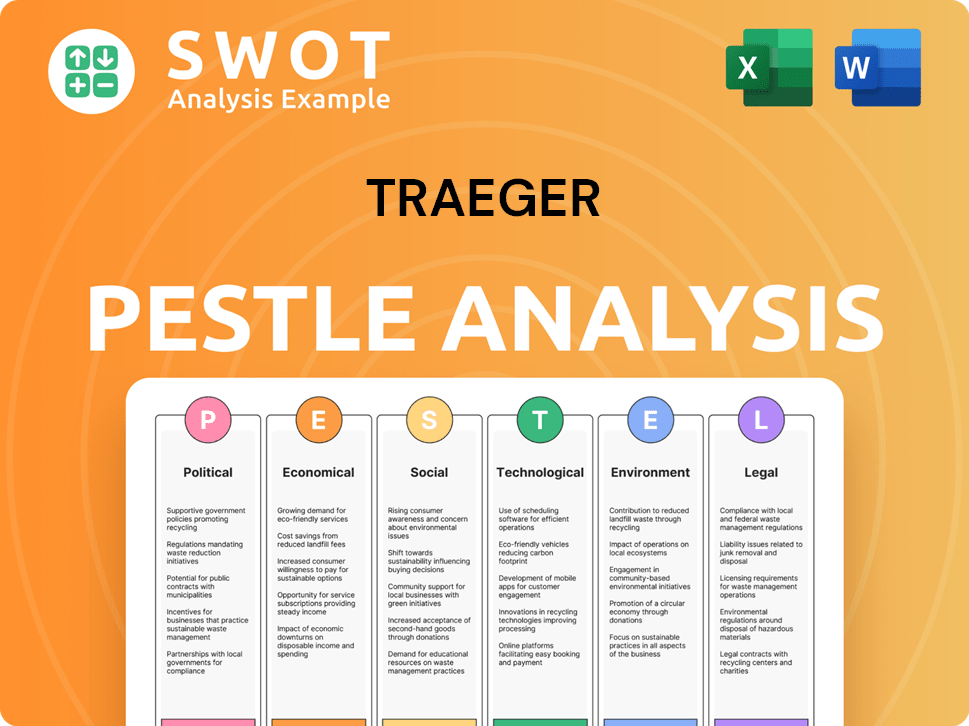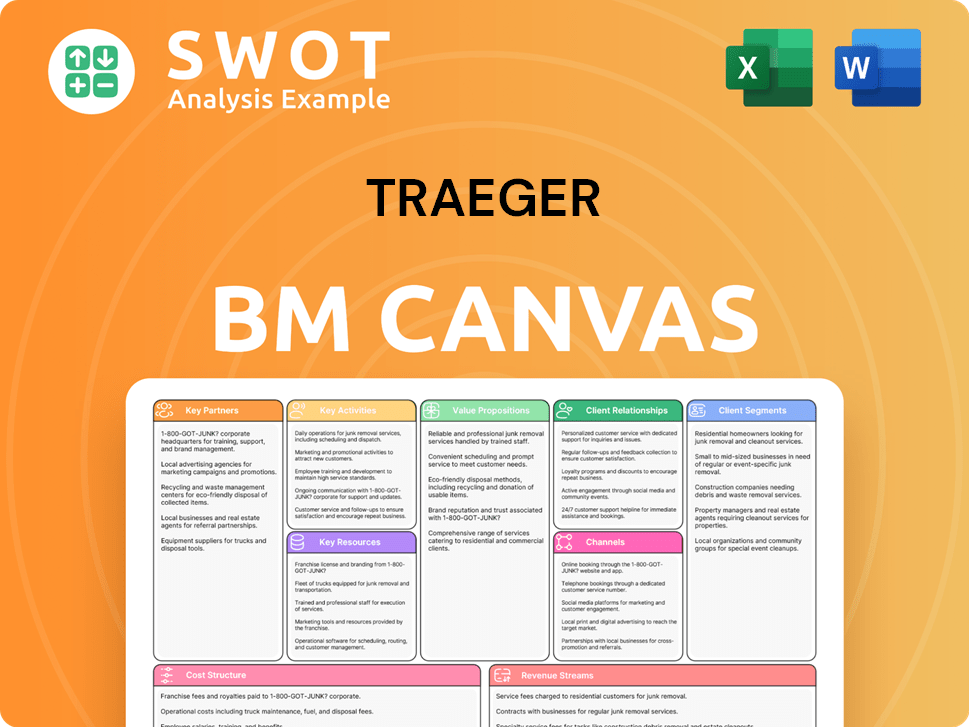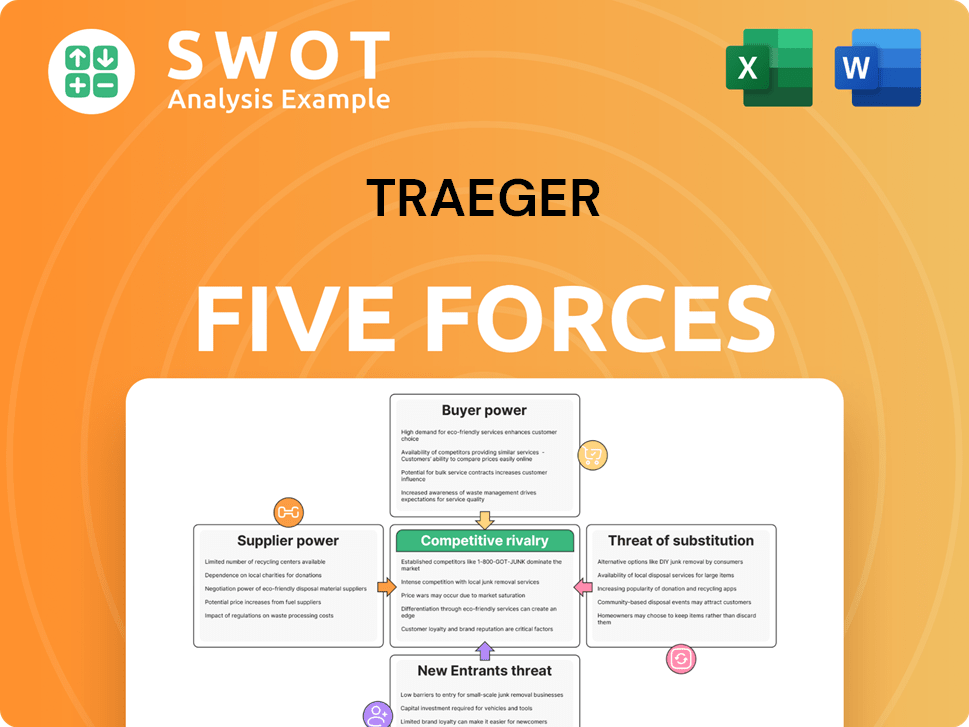Traeger Bundle
Can Traeger Conquer the Competitive Grill Market?
The outdoor cooking realm is sizzling with innovation, but how does Traeger, the pioneer of wood-fired pellet grills, stack up against its rivals? From advanced technology to unique culinary experiences, the Traeger SWOT Analysis unveils the competitive landscape. Founded in 1987, Traeger has transformed from a niche product into a publicly traded company.

This deep dive into the Traeger competitive landscape will explore the company's market position, examining its primary competitors within the grill industry and the broader BBQ market. We'll analyze Traeger's competitive advantages, including its distinct smoky flavor profile and connected grilling technology. Furthermore, we will conduct a comprehensive Traeger market analysis, comparing it to smoker brands and other key players, while also considering future trends in the Traeger competitive landscape.
Where Does Traeger’ Stand in the Current Market?
The company holds a strong market position within the outdoor cooking industry, particularly in the wood-fired grill segment. It is recognized as a dominant force in the pellet grill category. The company's core operations revolve around its wood-fired pellet grills, available in various sizes and models to cater to different consumer needs and price points. In addition to grills, the company offers a comprehensive ecosystem of related accessories, including wood pellets, rubs, sauces, and grill covers, which contribute significantly to its revenue and customer retention.
The company's value proposition centers on providing a premium grilling experience through wood-fired cooking. It differentiates itself from traditional gas or charcoal grill manufacturers by emphasizing the unique flavor benefits of wood-fired cooking and continuous innovation in grill technology, such as WiFIRE connectivity. The company targets a broad customer segment, ranging from casual backyard grillers to barbecue enthusiasts seeking a premium grilling experience. The company's geographic presence is primarily concentrated in North America, where it has established a robust retail and direct-to-consumer distribution network.
While specific market share figures for 2024 or 2025 are not readily available, the company reported net sales of $150.3 million for the first quarter of 2024, demonstrating its substantial scale within the industry. The company's focus on brand building and a loyal customer base has further solidified its position, particularly in the United States and Canada, where it maintains a strong presence in specialized outdoor living retail channels and e-commerce. For more insights, explore the Growth Strategy of Traeger.
The company faces competition from various players in the grill industry, including both established brands and emerging competitors. The competitive environment is dynamic, with companies constantly innovating to capture market share. Understanding the competitive landscape is crucial for assessing the company's market position and growth potential.
Key competitors include brands like Weber, Pit Boss, and others offering pellet grills and related products. These competitors often have different strengths and weaknesses, influencing their market strategies. The competitive dynamics within the smoker brands segment are intense, with each brand vying for consumer attention and loyalty.
While precise market share data for 2024 or 2025 is unavailable, the company is a leader in the pellet grill category. The company's market share is influenced by factors such as product innovation, brand recognition, and distribution networks. Analyzing the company's market share provides insights into its competitive standing within the grill industry.
Competitive advantages include the unique wood-fired cooking experience, WiFIRE technology, and a strong brand reputation. These advantages help the company differentiate its products and attract customers. The company's focus on innovation and customer experience contributes to its competitive edge.
The company's strengths include a strong brand, innovative products, and a loyal customer base. Weaknesses may include higher price points compared to some competitors and potential supply chain vulnerabilities. Evaluating these factors is crucial for understanding the company's overall competitive position.
- Strengths: Strong brand recognition, innovative features like WiFIRE.
- Weaknesses: Higher price points, reliance on specific distribution channels.
- Opportunities: Expanding into new markets, product diversification.
- Threats: Increased competition, economic downturns affecting consumer spending.
Traeger SWOT Analysis
- Complete SWOT Breakdown
- Fully Customizable
- Editable in Excel & Word
- Professional Formatting
- Investor-Ready Format

Who Are the Main Competitors Challenging Traeger?
The Traeger competitive landscape is dynamic, with several key players vying for market share in the grill industry. This competitive environment is shaped by both established grill manufacturers and emerging brands, each employing different strategies to attract consumers. Understanding these competitors and their approaches is crucial for assessing Traeger's market position and potential for growth.
The BBQ market, and specifically the pellet grill segment, has seen significant growth, attracting various competitors. These competitors challenge Traeger through a mix of brand recognition, pricing strategies, product innovation, and distribution networks. The competitive dynamics are further influenced by consumer preferences, technological advancements, and broader economic factors.
Traeger faces a competitive landscape comprised of both established grill manufacturers and emerging brands, all vying for market share in the outdoor cooking sector. One of its most significant direct competitors is Weber-Stephen Products LLC, a long-standing leader in the grilling industry known for its charcoal and gas grills. Weber has also expanded its offerings to include pellet grills, directly challenging Traeger in its core segment, often competing on brand recognition and a broader product portfolio. Another formidable direct competitor is Z Grills, which often competes on price, offering more budget-friendly pellet grill options that appeal to a different segment of the market. Pit Boss Grills, a brand under Dansons, Inc., is also a major rival, known for its robust and feature-rich pellet grills that often offer competitive pricing and a strong presence in mass retail channels.
Weber is a dominant player in the grill industry, known for its strong brand recognition and extensive product range. They compete with Traeger by offering a wide variety of grills, including pellet grills, and leveraging their established distribution network.
Z Grills focuses on offering budget-friendly pellet grill options, competing with Traeger primarily on price. They target a different segment of the market by providing similar functionality at a lower cost.
Pit Boss Grills competes with Traeger by offering robust and feature-rich pellet grills, often at competitive prices. They have a strong presence in mass retail channels, making their products accessible to a wide audience.
Other competitors include brands focusing on niche markets or disruptive technologies. These may include portable pellet grills or grills with advanced smart features, presenting an evolving challenge to Traeger's market leadership.
Competitors challenge Traeger through various means, including extensive distribution networks, brand loyalty, and competitive pricing. Innovation in smart grilling technology, such as Wi-Fi connectivity and app integration, is a key battleground.
The outdoor cooking industry is robust, with new players entering the market. These new entrants often focus on niche markets or disruptive technologies, which poses an evolving challenge to Traeger's sustained market leadership.
Several factors influence the competitive landscape for Traeger and its rivals. These include brand recognition, pricing, product features, distribution channels, and technological innovation. The ability to adapt to changing consumer preferences and market trends is also critical.
- Brand Recognition: Weber's established brand is a significant advantage.
- Pricing: Z Grills and Pit Boss compete on value.
- Product Features: Smart grilling technology is a key battleground.
- Distribution: Weber's extensive network is a strength.
- Innovation: New entrants focus on niche markets and technologies.
Traeger PESTLE Analysis
- Covers All 6 PESTLE Categories
- No Research Needed – Save Hours of Work
- Built by Experts, Trusted by Consultants
- Instant Download, Ready to Use
- 100% Editable, Fully Customizable

What Gives Traeger a Competitive Edge Over Its Rivals?
Understanding the competitive landscape of the grill industry, particularly for companies like Traeger, involves analyzing key milestones, strategic moves, and competitive advantages. The company's journey has been marked by pioneering the wood-fired pellet grill market. This early entry has allowed it to establish a strong brand presence and cultivate a loyal customer base, often referred to as the 'Traeger Nation'.
Strategic moves include continuous innovation in grill technology, such as the WiFIRE connectivity system, and expansion of product offerings to cater to diverse consumer needs. These actions have solidified its position and enabled it to command higher price points compared to some competitors. A thorough Traeger market analysis is crucial for investors and industry watchers alike.
The competitive edge is further enhanced by a robust ecosystem of products, including proprietary wood pellet fuel, and a strong distribution network. These factors contribute to high customer retention and repeat purchases. By examining these elements, stakeholders can gain a comprehensive understanding of its strengths and weaknesses within the broader BBQ market.
Traeger's early entry into the wood-fired pellet grill market established a first-mover advantage. This allowed the company to define the category and build brand recognition. It has fostered a strong brand identity and a loyal customer base.
The company's brand equity is substantial, built through consistent marketing and community engagement. This strong brand allows it to command higher price points. The 'Traeger Nation' demonstrates strong customer loyalty, leading to repeat purchases.
The WiFIRE connectivity system is a key differentiator, appealing to tech-savvy consumers. This innovation enhances the user experience by offering remote control and monitoring. Continuous investment in R&D helps refine its grill technology.
A strong distribution network, including specialized retailers and e-commerce, ensures wide product accessibility. Economies of scale in manufacturing and distribution contribute to cost efficiencies. The company has a well-established supply chain.
The company's competitive advantages are multifaceted, including a strong brand, technological innovation, and a robust ecosystem. These advantages have enabled it to maintain a significant market share in the grill industry. The company's ability to innovate and adapt to consumer demands is a key factor in its continued success.
- Proprietary Wood Pellets: The wood pellet fuel delivers a distinct smoky flavor, differentiating it from gas or charcoal grills.
- WiFIRE Technology: The WiFIRE system allows remote control, enhancing convenience and user experience.
- Strong Brand and Community: Consistent marketing and community engagement foster strong brand loyalty.
- Distribution Network: Wide accessibility through specialized retailers and e-commerce.
Traeger Business Model Canvas
- Complete 9-Block Business Model Canvas
- Effortlessly Communicate Your Business Strategy
- Investor-Ready BMC Format
- 100% Editable and Customizable
- Clear and Structured Layout

What Industry Trends Are Reshaping Traeger’s Competitive Landscape?
The outdoor cooking industry is currently experiencing significant shifts, with increasing consumer demand for convenience, smart home integration, and diverse culinary experiences. Technological advancements, particularly in IoT and smart connectivity, are driving innovation in grill design and functionality. These trends shape the Traeger competitive landscape, presenting both challenges and opportunities for the brand. The rising consumer preference for healthier cooking methods and varied flavor profiles also plays into Traeger's wood-fired advantage.
For Traeger market analysis, potential disruptions include the entry of new competitors with innovative smart grill technologies or more sustainable fuel alternatives. The growing emphasis on sustainability and eco-friendly practices could also challenge Traeger to explore more environmentally conscious pellet sourcing and manufacturing. Declining discretionary spending due to economic downturns could impact sales of premium outdoor cooking equipment.
The grill industry is evolving with a focus on smart technology, convenience, and sustainable practices. Consumers are increasingly seeking grills with integrated features, such as temperature monitoring and remote control via smartphones. Healthier cooking methods and diverse flavor profiles, like those offered by wood-fired grills, are also gaining popularity. These trends influence the competitive dynamics within the BBQ market.
Traeger competitors face challenges from new market entrants with advanced smart grill technologies and the need for sustainable fuel alternatives. Intensified competition from established brands diversifying into the pellet grill market poses a threat. Economic downturns and changes in consumer spending habits could also impact sales of premium outdoor cooking equipment. Supply chain issues also impact competition.
Significant growth opportunities exist for Traeger in emerging markets, particularly in Asia and Europe, as the outdoor cooking culture expands globally. Product innovations, such as more advanced smart features and expanded accessory lines, could solidify market leadership. Strategic partnerships with food brands or smart home technology companies could also open new avenues for growth and market penetration.
Traeger's competitive position is evolving towards a greater emphasis on integrated technology, personalized cooking experiences, and sustainability. The company is deploying strategies to remain resilient by continuously innovating its product line, expanding its digital ecosystem, and strengthening its brand community. For more insights, check out Owners & Shareholders of Traeger.
Traeger should focus on continuous product innovation, especially in smart technology and sustainable practices, to maintain its market position. Expanding its digital ecosystem through app enhancements and online community engagement can strengthen customer loyalty. Forming strategic partnerships with food brands or tech companies can open new growth avenues.
- Invest in R&D for smart grill features and sustainable fuel options.
- Enhance the digital ecosystem with user-friendly apps and community features.
- Explore partnerships to broaden market reach and enhance brand value.
- Focus on eco-friendly practices throughout the supply chain.
Traeger Porter's Five Forces Analysis
- Covers All 5 Competitive Forces in Detail
- Structured for Consultants, Students, and Founders
- 100% Editable in Microsoft Word & Excel
- Instant Digital Download – Use Immediately
- Compatible with Mac & PC – Fully Unlocked

Related Blogs
- What are Mission Vision & Core Values of Traeger Company?
- What is Growth Strategy and Future Prospects of Traeger Company?
- How Does Traeger Company Work?
- What is Sales and Marketing Strategy of Traeger Company?
- What is Brief History of Traeger Company?
- Who Owns Traeger Company?
- What is Customer Demographics and Target Market of Traeger Company?
Disclaimer
All information, articles, and product details provided on this website are for general informational and educational purposes only. We do not claim any ownership over, nor do we intend to infringe upon, any trademarks, copyrights, logos, brand names, or other intellectual property mentioned or depicted on this site. Such intellectual property remains the property of its respective owners, and any references here are made solely for identification or informational purposes, without implying any affiliation, endorsement, or partnership.
We make no representations or warranties, express or implied, regarding the accuracy, completeness, or suitability of any content or products presented. Nothing on this website should be construed as legal, tax, investment, financial, medical, or other professional advice. In addition, no part of this site—including articles or product references—constitutes a solicitation, recommendation, endorsement, advertisement, or offer to buy or sell any securities, franchises, or other financial instruments, particularly in jurisdictions where such activity would be unlawful.
All content is of a general nature and may not address the specific circumstances of any individual or entity. It is not a substitute for professional advice or services. Any actions you take based on the information provided here are strictly at your own risk. You accept full responsibility for any decisions or outcomes arising from your use of this website and agree to release us from any liability in connection with your use of, or reliance upon, the content or products found herein.